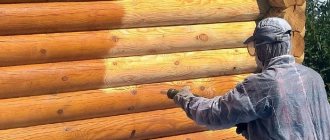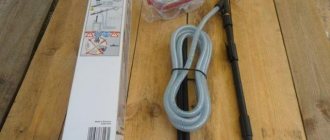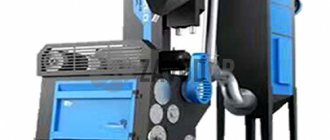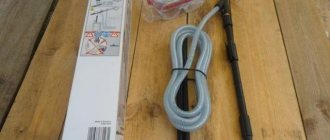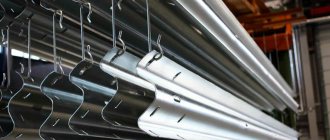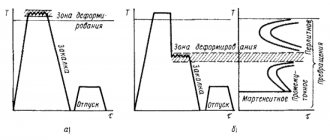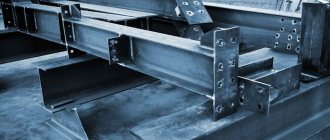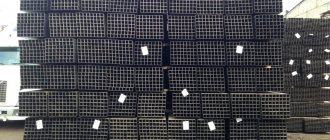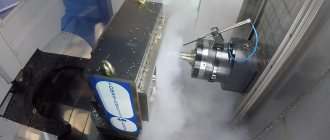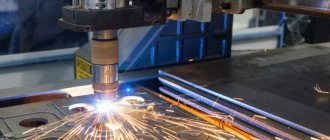From the outside, sandblasting resembles spray painting, when the metal caught under the jet changes its color. Only the surface is freed from coating and dirt and becomes matte, steel-colored.
There are different types of sandblasting used for specific purposes. Small sandblasting guns are used in everyday life. Industrial equipment is stationary, large and powerful.
What it is?
Sandblasting of metal is the mechanical removal of the top layer: rust and coating, due to numerous impacts of sand grains on the surface. Escaping from the nozzle under high pressure, the abrasive knocks out small particles of dirt, completely cleaning the metal.
A stream of sand is supplied by compressed air continuously, leaving behind a clean metal surface, removing from it:
- dirt;
- rust;
- oil stains;
- welding slags;
- paint;
- concrete and other building mixtures;
- primer.
What remains is a clean matte surface, ready for further processing.
Important!
Bitumen, tar and other viscous materials are difficult to remove by sandblasting. Abrasive particles stick to the top and are knocked out by the next stream of sand. Cleaning requires several times more sand and time. The exception is thermal sandblasting.
Definition
Sandblasting is a technology that allows for effective cleaning using abrasives. A flow of compressed air provides energy to the abrasive particles, then an air-abrasive mixture is supplied to the surface of the material being processed. The main goal of the work is to remove carbon deposits, mill scale, traces of corrosion, molding sand residues, contamination of various types of coating, oil stains, as well as obtain a specific roughness that improves the adhesion of the substrate.
Pros and cons of such cleaning of metal structures
Sandblasting has many advantages over other methods of cleaning metal and other surfaces:
- high performance;
- versatility, removes many types of contaminants;
- gentle processing;
- increasing adhesion of the treated surface;
- formation of hardening surface hardening;
- high quality cleaning;
- low cost;
- simplicity of equipment.
In most cases, the abrasive can be reused after cleaning. Sandblasting has its disadvantages. When grains of sand hit metal, a lot of dust rises. It contains a high content of quartz, iron oxides, and other harmful substances. The brown cloud consists of particles of broken sand and rust that has turned into dust. If they enter the lungs, these substances cause an occupational lung disease – silicosis.
Important!
Dust particles formed during sandblasting settle on the walls of the lungs and are not removed from the body. The disease is severe and leads to organ destruction.
When working with a sandblaster, you must wear a mask with an air filter. Professional shot blasters are provided with sealed protective suits with a supply under a helmet with a visor. When working with sandblasting, there is always a danger of falling under a stream of sand. Both the sandblaster himself and a stranger who happens to be nearby can suffer.
Degree of purification
The sandblasting procedure allows you to achieve several levels:
- - commercial - no traces of paint, rust, possibly scratches;
- - removing - the presence of residual traces of corrosion and old paint is acceptable;
- - deep, i.e. until the surface is completely clean. With this level of processing, it is possible to achieve the point that it is impossible to see old paint or rust even with multiple magnifications. But this degree of purification is only possible when using high-quality, expensive equipment.
Types of abrasives used
At the end of the 19th century, the American Benjamin Chu Tilghman drew attention to glass after a storm. They were completely cleaned of dirt by gusts of wind and sand and shone like new. He invented the first sandblasting machine, which used clean sand from the desert and sea. The hard, ribbed grains effectively removed all dirt.
Over time, the negative effects of dust on the lungs were discovered. The workers wore protective suits. We tried and began to use other materials. Modern sandblasting machines use:
- steel shot;
- corundum powder;
- glass balls;
- quartz sand;
- synthetic abrasives.
Sand is the cheapest abrasive material and continues to be used if protective equipment is available. The technology for making steel and cast iron shot is simple and at the same time dangerous. Molten metal is poured into water. As a result of boiling, pieces of metal with small fractions are formed.
Reference! In some countries it is prohibited to use sand for abrasive processing of parts. Safer materials are used.
Media[edit]
In the early 1900s, it was assumed that sharp-edged grains provided the best performance, but this was later shown to be incorrect. [14]
Mineral: Quartz sand can be used as a mineral abrasive. It tends to break down quickly, producing large amounts of dust, exposing the operator to the potential development of silicosis, a debilitating lung disease. To combat this danger, quartz sand for blasting is often coated with resins to control dust. For this reason, the use of silica as an abrasive is prohibited in Germany, Belgium, Russia, Sweden and the UK. [15] Silica is a common abrasive in countries where it is not prohibited. [16]
Another common mineral abrasive is garnet. Garnet is more expensive than quartz sand, but when used correctly will provide equivalent performance while producing less dust and without the risk of dust getting inside. Magnesium sulfate or kieserite is often used as an alternative to baking soda.
Agriculture: Typically crushed nut shells or fruit kernels. These soft abrasives are used to avoid damaging the base material, such as when cleaning brick or stone, removing graffiti, or removing coatings from printed circuit boards being repaired.
Synthetic: This category includes corn starch, wheat starch, sodium bicarbonate, and dry ice. These "soft" abrasives are also used to prevent damage to the base material, such as when cleaning brick or stone, removing graffiti, or removing coatings from printed circuit boards being repaired. Soda cleaning uses baking soda (sodium bicarbonate), which is extremely friable and the micro fragments on impact explode surface materials without damaging the substrate.
Additional synthetic abrasives include process by-products (such as copper slag, nickel slag, and coal slag), industrial abrasives (such as aluminum oxide, silicon carbide or carborundum, glass beads, ceramic shot/sand), and processed products (such as plastic abrasive) . , glass chips).
Metallic: steel shot, steel shot, stainless steel shot, cut wire, copper shot, aluminum shot, zinc shot.
Many of the rougher media used in sandblasting often result in the release of energy in the form of sparks or light upon impact. The color and size of the spark or glow varies significantly, from the heavy, bright orange sparks from shot blasting steel to the faint blue glow (often invisible in sunlight or brightly lit work areas) from garnet abrasive.
Types and technology, how to sandblast correctly?
The classic version of sandblasting - abrasive particles are carried by air and hit the surface with great force, knocking out dirt particles. Modernized devices have increased the cleaning efficiency and reduced their harmfulness.
Thermoabrasive
Cleaning is carried out simultaneously with sand and flame. A narrowly directed torch removes the abrasive, simultaneously heating it and burning fuel oil, paints, and other flammable materials from the surface. The coating softened by heat treatment is easier to remove with sand.
The thermoforming apparatus, in addition to a compressor and a container with sand, has a jet burner. It is similar in design to rocket and aircraft engines, but small in size. Runs on kerosene, gasoline and other types of fuel.
Thermal processing - thermo-blasting, used by professionals. It is intended for cleaning surfaces:
- brickwork;
- stone;
- oil tanks;
- containers for fat and oil.
Thermal sandblasting removes bitumen and multi-layer paint and varnish coatings, oil stains, diesel fuel, and other fatty and viscous materials.
Reference! At home, craftsmen use low-power thermo-blasters to clean containers of oil, “age” wood, and remove thick layers of paint.
Abrasive blasting
Classic type of sandblasting. The abrasive is carried away by the air flow. The nozzle forms the jet, changing its shape to conical, flat or almost cylindrical, without expansion. Hitting the surface, sharp solid particles knock out scale, oil, and primer from the metal surface. At the same time, they themselves are partially destroyed.
Abrasive blasting is used to clean parts for painting, grinding, and galvanic coating. It is widely used in auto repair shops, cleaning bodies and wheels, and other parts exposed to dirt and moisture. The spent abrasive can be collected, screened and cleaned for reuse.
Reference! Dust-free air blasters do not pollute the air and use abrasives repeatedly.
Waterjet
Hydraulic sandblasters use water as a carrier. It passes from the pump under high pressure. Along the way, it picks up sand. Spent abrasive and removed dirt are washed away without forming dust.
Water jet cleaning is used in rooms where dust formation is unacceptable. In special chambers it is used to clean parts from water-soluble coatings. Alkali particles penetrate into the small pores of the metal and ordinary dry abrasive only pushes it deeper, sealing the pores. Water dissolves the remaining detergents and carries them away.
Using water equipment, bridges, building metal structures, sidewalks, fences and house facades are cleaned. Water jet cleaning can be done if water drains are available. It is used in outdoor conditions and in special chambers.
Necessary equipment, devices
Industrial equipment for sandblasting consists of:
- main compressor supplying compressed air to the nozzle;
- an abrasive blasting machine that adds sand to the working hose;
- a sleeve through which air and sand flow;
- nozzle;
- an additional compressor supplies air to the worker’s protective suit;
- air filter.
The pressure produced by the compressor determines the power of the entire sandblasting unit. An abrasive blasting machine mixes air with sand in various ways:
- injection;
- gravitational;
- suction
An additional low-power compressor supplies air through a filter under the protective suit mask, providing the worker with the opportunity to breathe normally. Sandblasting guns are available for small jobs and home use. They have a power of 3-5 Atm and are equipped with a compact compressor. A small amount of metal stripping is carried out in a respirator.
Consumption of quartz sand
To calculate the average consumption, the general ratio is correct: per 1 sq.m - 30 kg of abrasive*.
If you use less powerful devices with an air flow rate of 200 l/min, approximately 0.25 kg/min of sand will be consumed. In high-power compressors with an air flow rate of about 10 cubic meters/min, the cost of quartz sand will be up to 12 kg. *We provide approximate figures and are for reference only. Specific indicators depend on various factors: the power of the sandblasting unit, the volume of work, the degree of surface contamination, the characteristics of quartz sand and some others. The RosQuarts company offers to buy quartz sand for cleaning metal structures at the best prices with delivery to the site anywhere in Russia and the CIS countries.
Main rules of the procedure
The workpiece should be installed in a position convenient for work and secured. Most of the surface to be treated should be located in a vertical plane.
Check the readiness of the device:
- Pour abrasive into the container.
- Connect the compressor.
- Check its operation at idle speed.
- Point the nozzle towards the part and turn on the sand supply.
The abrasive jet is moved vertically or horizontally over the surface being treated. Each subsequent stripe should overlap the previous one by 30%.
Important!
Massive parts weighing more than a ton do not need to be secured, just placed on a flat surface.
Safety precautions
Before working with sandblasting equipment, you must wear a protective suit. Check all cables and hoses for defects. Replace immediately if necessary. Inspect the nozzle. If the degree of wear is large, install a new nozzle.
The work site must be cleared of foreign objects and protected from people. If the shot blaster is working with an assistant, he should be behind him and go out to re-edge the part or fill the sand with the machine turned off. It is strictly forbidden to point the nozzle at yourself or other people. This could result in serious injury.
Processing price per m2
The cost of sandblasting depends on the configuration of the part, the complexity of its processing and the company. Approximate cost:
- casting from 290 rub./m2;
- fences and gratings 300 rub./m2;
- roofing metal 380 rub./m2;
- vertically located steel structures 300 rub./m2;
- car wheels 500 rub. per piece;
- kenguryatnik 670 rub.
For 250 rubles. specialists will completely clean the car body and only 1 m2 of the ship’s hull.
Sandblasting is the cheapest way to clean metal. With its help, it is easy to process profiles of any complexity, remove scale and old paint from water pipes and tanks. Household equipment is used to clean cars during repairs, remove old finishes from walls, clean porches and paths, and wash facades. The scope is wide. It is necessary to remember safety at all times.
Benefits of processing
The benefits of sandblasting metal include:
- — processing equipment can be used not only in specially equipped premises, but also at a construction site, when carrying out underground and high-rise work, taking into account the geographical remoteness of objects;
- — wide scope of application;
- - efficiency;
- — the coating applied after treatment will last much longer, thanks to the deep cleaning of the metal coating;
- - low complexity of application.
